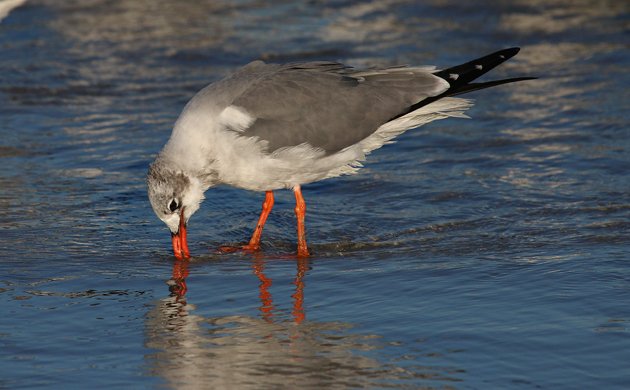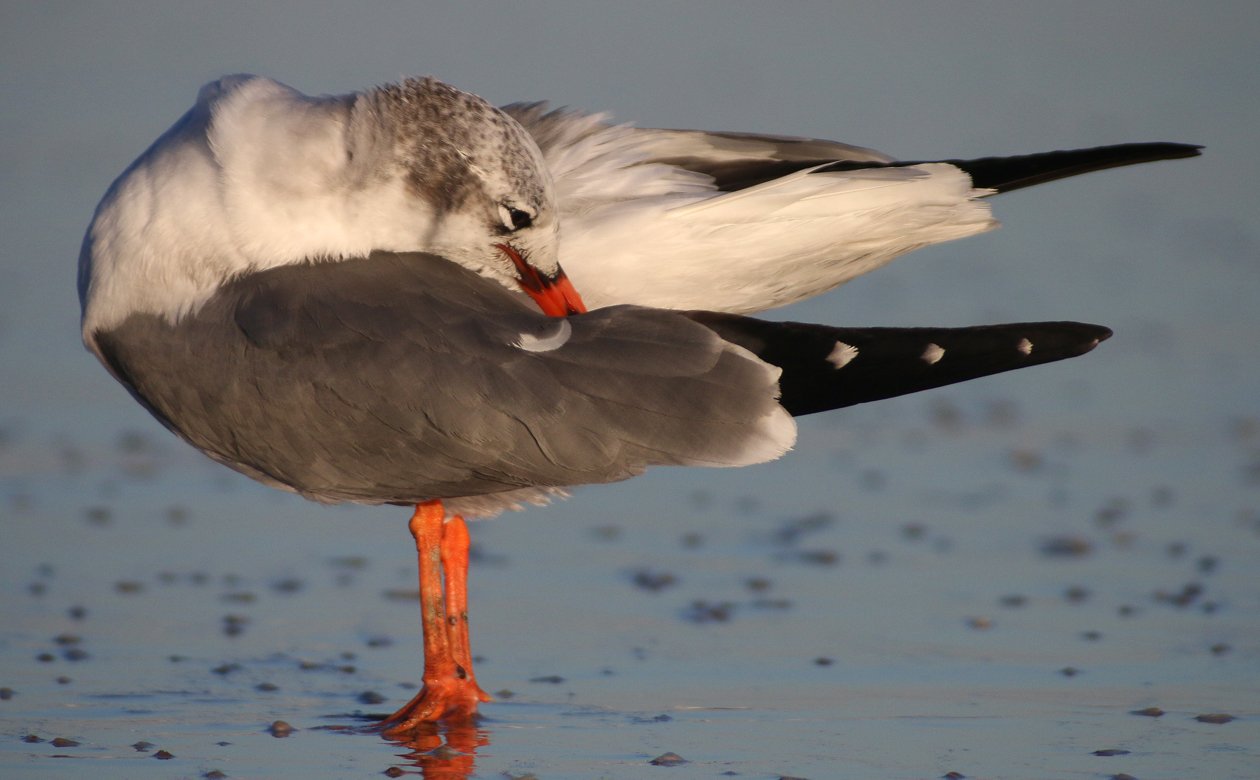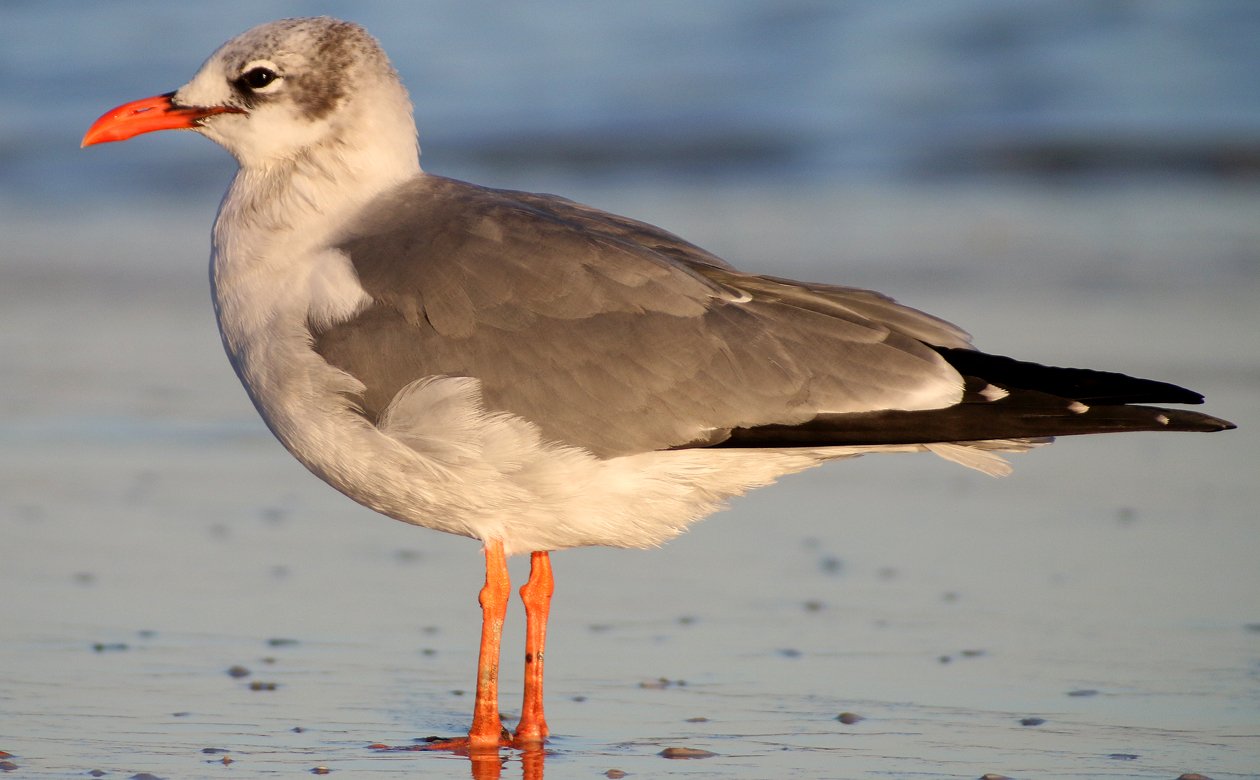
While at the Space Coast Birding and Wildlife Festival I could not resist making the drive north to Daytona Beach one day to witness the awesome gull fly-in from the dump to the beach. Every evening in winter an impressive array of a variety of gulls leave the nearby dump in the evening and come to loaf on the beach for awhile before they fly out to sea for the night. This is perhaps the best place in Florida to find a rare gull for the state and though I had no luck picking a vagrant California Gull out of the teeming hordes I did enjoy myself as much as I did back in 2012.
But my failure to find a rare species doesn’t mean that I saw nothing of note. One bird in particular got my pulse racing for a bit before I figured out I was looking at the most common species on the beach, albeit in a form that is exceedingly odd.
Laughing Gulls numbering well over 10,000 in number form the bulk of the birds on the beach in Daytona Beach but this bird was weird. In winter, Laughing Gulls should have black legs and bill and in alternate, or breeding plumage, those parts, while staying dark, get a nice deep red color. So you can imagine when I saw a bird that looked similar to the expected Laughing Gulls but with a bright orange bill and bright orange legs I was pretty excited because I thought I had found something rare, like a Black-headed Gull.
But as I examined the bird closely, which wasn’t a problem on a beach where the gulls get very accustomed to people being around them, I realized that the only thing that differentiated this bird from the other Laughing Gulls was the color of its bill and legs. In size, structure, plumage, and everything else it was a Laughing Gull.
When I pointed the bird out to some other birders they let me know that this orange-billed-and-legged Laughing Gull had been around all winter and that this aberrant appearance isn’t terribly uncommon among Laughing Gulls. And later, when I posted a picture of it on my Facebook page another birder shared an image of a similar bird taken in Panama. Interestingly, no one seems to know what is going on with these birds, whether the color is diet related or genetic, how often, exactly, that they occur, or much of anything. At least, no one knows what is going on with these birds who has posted that information online in an easy-to-find way.
Cool bird, no? And if you happen to know what is happening with these birds, or even if you just have a theory, please let me know in the comments. Thanks!
…
10,000 Birds is a Scrub-Jay level sponsor of the 2014 Space Coast Birding and Wildlife Festival.
…















Corey, I have photographed Laughing Gulls with strange coloration of the legs and bills that are not as complete as your gulls shows. For lack of a better term I called them Pinto Bean gulls because the patterns remind me of beans.
You can see two examples here: http://onthewingphotography.com/wings/2010/09/08/pinto-bean-gulls/
I’d be interested in knowing what causes this too.
Mia, those gulls are pretty cool. If I hear anything about what is going on these types of Laughing Gulls I’ll drop you a line.
I’ve seen the same red/orange dichotomy with cardinals that have orange feathers. My guess is that about 1 in 100 probably fall in this category. Typically the orange coloration is of similar hue across the animal.
Unfortunetly the enzyme in birds that creates the red pigment, a carotenoid known as astaxanthin, has not yet been discovered, but hopefully soon will be. George Wald, the Nobel Laureate who won the nobel prize in Phys. & Med. in 1967 called out for the search for this enzyme in 1937 while examining red oil-droplets in the retina of Chickens (they use red oil droplets to filter light as all birds do – perhaps 1 or 2 nocturnal exceptions). This red pigment making enzyme, likely in the retina as G. Wald suggests, is also likely the same one that makes red pigments for feathers and scales – at least the historical odds are that it is. In the latter case the red enzyme gene would be “turned on” in the liver, or skin, scales or bare parts, much as it would be turned on in the retina to fill red-colored oil-droplets for vision.
The red condition w.r.t. ornamentation appears to be clearly sex-linked since during breeding season dark red pigments (likely red carotenoids) are deposited in the dermal leg scales of the male (redefining what sexy legs are). So, as a first hypothesis, males may require a controlling/modulating gene on its 2 Z chromosomes (sex chromosomes) that interacts somehow with this unknown enzyme that makes red pigment. If the male is not homozygous for this trait (2 good copies of this gene, one copy each on both Z chromosomes), the red pigment making enzyme may only operate at ~50% levels – thereby producing the orange condition. So, perhaps the process follows simple Mendelian genetics (this genetics question was likely answered by early German ornithologists who studied color traits). Of course it could be a number of things but this red –> orange shift is not uncommon among birds, but is rare.
If both of the two genes on the two Z chromosomes are dysfunctional for some reason then you may get the rare yellow condition phenotype as seen in mutant male cardinals that are yellow. Obv one could make many speculative arguments at the molecular level, excluding the Z chromosomes of males – we’ll just have to wait until this red enzyme is discovered before we can get the goods on how this system operates and is controlled.
And just to demonstrate that these question are not so straight forward take the cardinal again as an example. Red feathers, red oil-droplets in the retina, but orange beaks. Perhaps in these cases the unknown red enzyme is puttering along at half expression much like in the beaks and feathers of female.
And finally, both male and female cardinals need a fully functional red pigment producing enzyme in their retinas, so, since females only have 1 Z chromosome and not 2 like males, they would have a have a way to “over-express” this enzyme in the retina in order that they too, like the males, have enought pigment to support excellent vision.
Whatever the cause, it must also explain this image of a cardinal 1/2 red, 1/2 yellow (but even here the red half appears to be orange. This latter condition may be the results of disproprtionate distribution of the Z chromosome during early cell division.
Scientists are on the cusp of finding this long lost red-pigment producing enzyme in brids (turtles have it too, and some reptiles, and the Austrailian lungfish). Stand by, your answers for these and other similar questions are only a “…hmm, that’s interesting” event away from discovery.
Keep sharing the exciting photos and happy birding!
P.S. I am not a geneticist, only repsonding to the poster’s request for a hypothesis. My first though was it must be genetically link – certainly not dietary (though one might imagine under special conditions it might be).
Thanks Corey, I’d love to know what causes these variations in colors of the bills and legs of Laughing Gulls.
Louis, thanks for the fascinating information. I’m not sure how relevant it is to this particular situation, however, as in winter Laughing Gulls should have black legs and bills.
I saw the orange billed / legged laughing gull on Sanibel Island last week. How strange.
we recently observed a reg pigmented LAGU on Topsail Hill State park, 15 Dec 2014 and searching for info and came up this blog site. Thought I’d share
ii saw what must be the same individual yesterday and today while birding by bike in Daytona.
Hi Mike, I took an image of a similar orange legged and billed non-breeding laughing gull in Daytona Beach back in January, 2013. It looks identical to the other laughing gulls in the picture except for the orange legs and bill and the fact that it wasn’t showing the white dots on the outer tail feather edges. It is very unusual bird for sure and it certaily stands out in a crowd. You can see my image in my viewbug gallery at: https://www.viewbug.com/photo/96649051
If you have learned any more about this oddity, please let me know. I am very interested.
Kurt Snyder
I have seen a similar bird in Antigua and Barbuda on 14 June, 2022.
Hey there…not sure if Corey is still looking at this. I photographed an orange-legged/bill Laughing Gull on Kiawah Island, SC September 17, 2022. https://ebird.org/checklist/S118945013
Interestingly, I had a dark morph (for lack of a better term) Laughing Gull from the Dry Tortugas back in 2006. Like you, I got very excited initially, but the more I looked the more it looked like laughing. Other folks agreed.